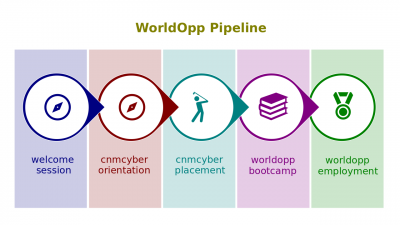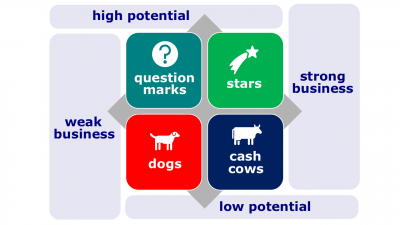Difference between revisions of "Career Effort Portfolios"
(→Script) |
(→Script) |
||
| Line 22: | Line 22: | ||
:The ''BCG matrix'' positions all the endeavors in one of four quadrants. The matrix creators called weak-business low-potentials ''dogs''; they should be allowed going out. Strong-business low-potentials are ''cash cows''; they should be kept. Weak-business high-potentials are ''question marks''; they might be considered being moved to ''stars'' if ''stars'' are needed. Strong-business high-potentials are ''stars''; they should be nourished. | :The ''BCG matrix'' positions all the endeavors in one of four quadrants. The matrix creators called weak-business low-potentials ''dogs''; they should be allowed going out. Strong-business low-potentials are ''cash cows''; they should be kept. Weak-business high-potentials are ''question marks''; they might be considered being moved to ''stars'' if ''stars'' are needed. Strong-business high-potentials are ''stars''; they should be nourished. | ||
| + | :How does the ''matrix'' work? Let's imagine a [[teacher]], who loves teaching and is satisfied with the current ''compensation'', but would like to have more professional flexibility because she is limited at her current job. | ||
| + | :Under these circumstances, the current job would fit the ''cash cow''; it needs to be kept. If this teacher launches her own teaching business, that endeavor may fit a ''question mark''. If that ''business'' doesn't succeed financially, she would still enjoy opportunities to be whomever she wants to be. If that ''business'' moves to the financial ''stars'', she may consider quitting her current job. | ||
'''[[Career Tactics]]''' is the successor [[lectio]]. | '''[[Career Tactics]]''' is the successor [[lectio]]. | ||
==Quiz== | ==Quiz== | ||
Revision as of 20:04, 11 May 2020
Career Strategies (hereinafter, the Lectio) is the second lesson part of the Career Essentials lesson that introduces its participants to careers and related topics.
This lesson belongs to the Introduction to Careers session of the CNM Cyber Orientation. The Orientation is the second stage of the WorldOpp Pipeline.
Contents
Content
The predecessor lectio is Career Levels.
Key terms
- [[]].
Script
- A career strategy is a high-level plan to achieve one or more career goals under conditions of uncertainty. No unified strategy exists; every strategy depends on what one's career goals are.
- Reflecting the Work Motivation Model, career goals may refer to better work-life fit, employee compensation, or job tasks.
- Every goal may require its own career tactic to achieve. So, the strategy can be referred as a composition of tactics.
- The BCG matrix is the leading tool that c-level executives use to formulate the strategy. With regard to career administration, this matrix may help in resource allocation decisions on the basis of the worker's competitiveness and goal attaining potential of various career endeavors. Strong business refers to high competitiveness and vice versa.
- The BCG matrix positions all the endeavors in one of four quadrants. The matrix creators called weak-business low-potentials dogs; they should be allowed going out. Strong-business low-potentials are cash cows; they should be kept. Weak-business high-potentials are question marks; they might be considered being moved to stars if stars are needed. Strong-business high-potentials are stars; they should be nourished.
- How does the matrix work? Let's imagine a teacher, who loves teaching and is satisfied with the current compensation, but would like to have more professional flexibility because she is limited at her current job.
- Under these circumstances, the current job would fit the cash cow; it needs to be kept. If this teacher launches her own teaching business, that endeavor may fit a question mark. If that business doesn't succeed financially, she would still enjoy opportunities to be whomever she wants to be. If that business moves to the financial stars, she may consider quitting her current job.
Career Tactics is the successor lectio.

